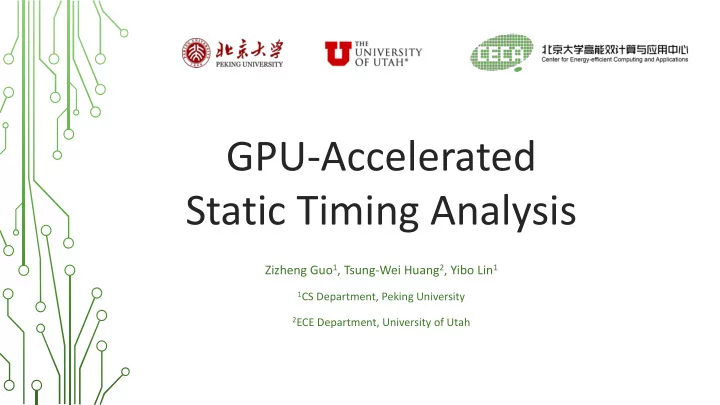

GPU-Accelerated Static Timing Analysis Zizheng Guo 1 , Tsung-Wei Huang 2 , Yibo Lin 1 1 CS Department, Peking University 2 ECE Department, University of Utah
Outline 2 Introduction – Static timing analysis (STA) – Previous work on STA acceleration Problem formulation and our proposed algorithms – RC delay computation – Levelization – Timing propagation Experimental result Conclusion
Static Timing Analysis: Basic Concepts 3 Correct functionality Performance Image source: https://www.synopsys.com/glossary/what-is-static-timing-analysis.html https://vlsiuniverse.blogspot.com/2016/12/setup-time-vs-hold-time.html https://sites.google.com/site/taucontest2015/
Static Timing Analysis: Basic Concepts 4 Correct functionality and performance Simplified delay models – Cell delay: non-linear delay model (NLDM) – Net delay: Elmore delay model (Parasitic RC Tree) Image source: https://www.synopsys.com/glossary/what-is-static-timing-analysis.html https://vlsiuniverse.blogspot.com/2016/12/setup-time-vs-hold-time.html https://sites.google.com/site/taucontest2015/
Static Timing Analysis: Call For Acceleration 5 Time-consuming for million/billion-size VLSI designs Need to be called many times to guide optimization – Timing-driven placement, timing-driven routing etc. Image source: ePlace [Lu, TODAES’15], Dr. CU [Chen, TCAD’20]
Prior Works and Challenges 6 Parallelization on CPU by multithreading – [Huang, ICCAD’15] [Lee, ASP - DAC’18]... – cannot scale beyond 8-16 threads Statistical STA acceleration using GPU – [Gulati, ASPDAC’09] [Cong, FPGA’10]... – Less challenging than conventional STA Image source: [Huang, TCAD’20] https://docs.nvidia.com/cuda/cuda-c-programming-guide/index.html#introduction
Prior Works and Challenges 7 Accelerate STA using modern GPU – Lookup table query and timing propagation [Wang, ICPP’14] [Murray, FPT’18] – 6.2x kernel time speed-up, but 0.9x of entire time because of data copying Leveraging GPU is challenging – Graph-oriented: diverse computational patterns and irregular memory access – Data copy overhead Image source: [Huang, TCAD’20] https://docs.nvidia.com/cuda/cuda-c-programming-guide/index.html#introduction
Fully GPU-Accelerated STA 8 Efficient GPU algorithms – Covers the runtime bottlenecks Implementation based on open source STA engine OpenTimer https://github.com/OpenTimer/OpenTimer
RC Delay Computation 9 The Elmore delay model explained. 𝑚𝑝𝑏𝑒 𝑣 = σ 𝑤 is child of 𝑣 𝑑𝑏𝑞 𝑤 – eg. 𝑚𝑝𝑏𝑒 𝐵 = 𝑑𝑏𝑞 𝐵 + 𝑑𝑏𝑞 𝐶 + 𝑑𝑏𝑞 𝐷 + 𝑑𝑏𝑞 𝐸 = 𝑑𝑏𝑞 𝐵 + 𝑚𝑝𝑏𝑒 𝐶 + 𝑚𝑝𝑏𝑒 𝐸 𝑒𝑓𝑚𝑏𝑧 𝑣 = σ 𝑤 is any node 𝑑𝑏𝑞 𝑤 × 𝑆 𝑎→𝑀𝐷𝐵 𝑣,𝑤 – eg. 𝑒𝑓𝑚𝑏𝑧 𝐶 = 𝑑𝑏𝑞 𝐵 𝑆 𝑎→𝐵 + 𝑑𝑏𝑞 𝐸 𝑆 𝑎→𝐵 + 𝑑𝑏𝑞 𝐶 𝑆 𝑎→𝐶 + 𝑑𝑏𝑞 𝐷 𝑆 𝑎→𝐶 = 𝑒𝑓𝑚𝑏𝑧 𝐵 + 𝑆 𝐵→𝐶 𝑚𝑝𝑏𝑒 𝐶
RC Delay Computation 10 The Elmore delay model explained. 𝑚𝑒𝑓𝑚𝑏𝑧 𝑣 = σ 𝑤 is child of 𝑣 𝑑𝑏𝑞 𝑤 × 𝑒𝑓𝑚𝑏𝑧 𝑤 𝛾 𝑤 = σ 𝑤 is any node 𝑑𝑏𝑞 𝑤 × 𝑒𝑓𝑚𝑏𝑧 𝑤 × 𝑆 𝑎→𝑀𝐷𝐵 𝑣,𝑤
RC Delay Computation 11 Flatten the RC trees by parallel BFS and counting sort on GPU. Store only parent index of each node on GPU Redesign the dynamic programming on trees
RC Delay Computation 12 Store only parent index of each node on GPU Redesign the dynamic programming on trees DFS_load(u): load[u] = cap[u] For child v of u: DFS_load(v) load[u] += load[v] GPU_load: For u in [ C, D, B, E, A ]: load[u] += cap[u] load[u.parent] += load[u]
RC Delay Computation 13 Store only parent index of each node on GPU, and re-implement the dynamic programming on trees, based on the direction of value update. DFS_delay(u): For child v of u: temp := R[u,v]*load[v] delay[v] = delay[u] + temp DFS_delay(v) GPU_delay: For u in [ A, E, B, D, C ]: temp := R[u.parent,u]*load[u] delay[u]=delay[u.parent] + temp
RC Delay Memory Coalesce 14 Global memory read/write introduces delay. GPU will automatically coalesce adjacent memory requests. Image source: https://docs.nvidia.com/cuda/cuda-c- programming-guide/index.html#memory-hierarchy
Task Graph Levelization 15 Build level-by-level dependencies for timing propagation tasks. – Essentially a parallel topological sorting. Maintain a set of nodes called frontiers, and update the set using “advance” operation.
Task Graph Levelization: Reverse Technique 16 Benchmark #nodes Max In-degree Max Out-degree netcard 3999174 8 260 vga_lcd 397809 12 329 wb_dma 13125 12 95
GPU Look-up Table Query 17 Do linear interpolation/extrapolation and eliminate unnecessary branches – Unified inter-/extrapolation – Degenerated LUTs
Experiment Setup 18 Nvidia CUDA, RTX 2080, 40 Intel Xeon Gold 6138 CPU cores RC Tree Flattening – 64 threads per block with one block for each net Elmore delay computation – 4 threads for each net (one for each Early/Late and Rise/Fall condition) with a block of 64 nets Levelization – 128 threads per block Timing propagation – 4 threads for each arc, with a block of 32 arcs
Experimental Results 19 Up to 3.69 × speed-up (including data copy) Bigger performance margin with bigger problem size
Experimental Results 20 Up to 3.69 × speed-up (including data copy) Bigger performance margin with bigger problem size
Experimental Results (Incremental Timing) 21 Break-even point – 45K nets and gates – 67K propagation candidates useful for timing driven optimization Mixed strategy
Conclusions and Future Work 22 Conclusions: – GPU-accelerated STA that go beyond the scalability of existing methods – GPU-efficient data structures and algorithms for delay computation, levelization and timing propagation – Up to 3.69x speedup Future Work – Explore different cell/net delay models. – Develop efficient GPU algorithms for CPPR
Thanks! Questions are welcome Website: https://guozz.cn Email: gzz@pku.edu.cn
Recommend
More recommend